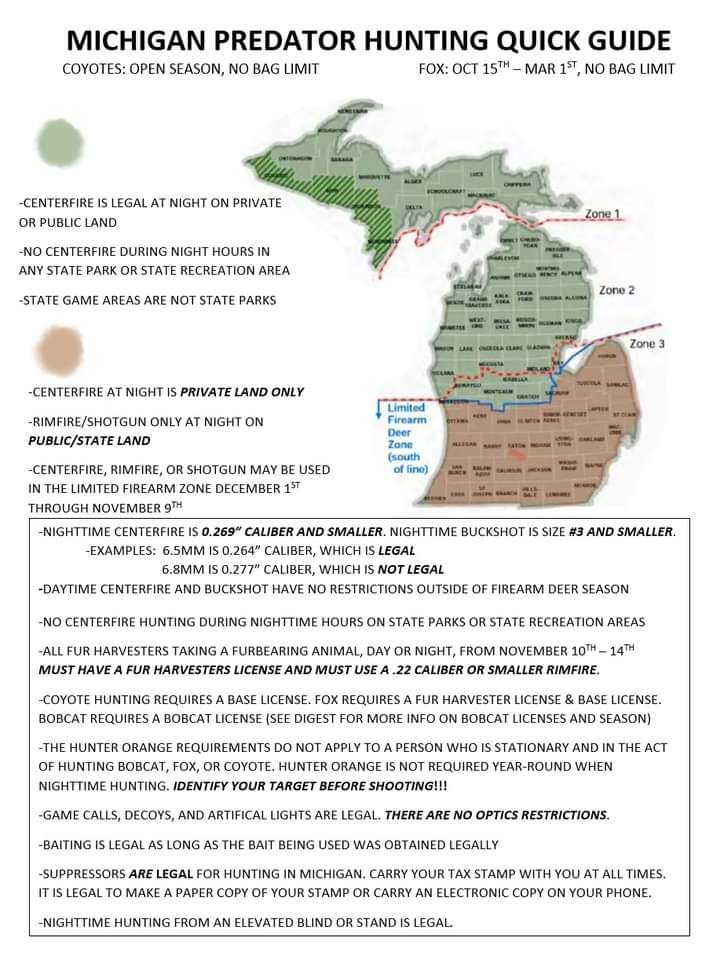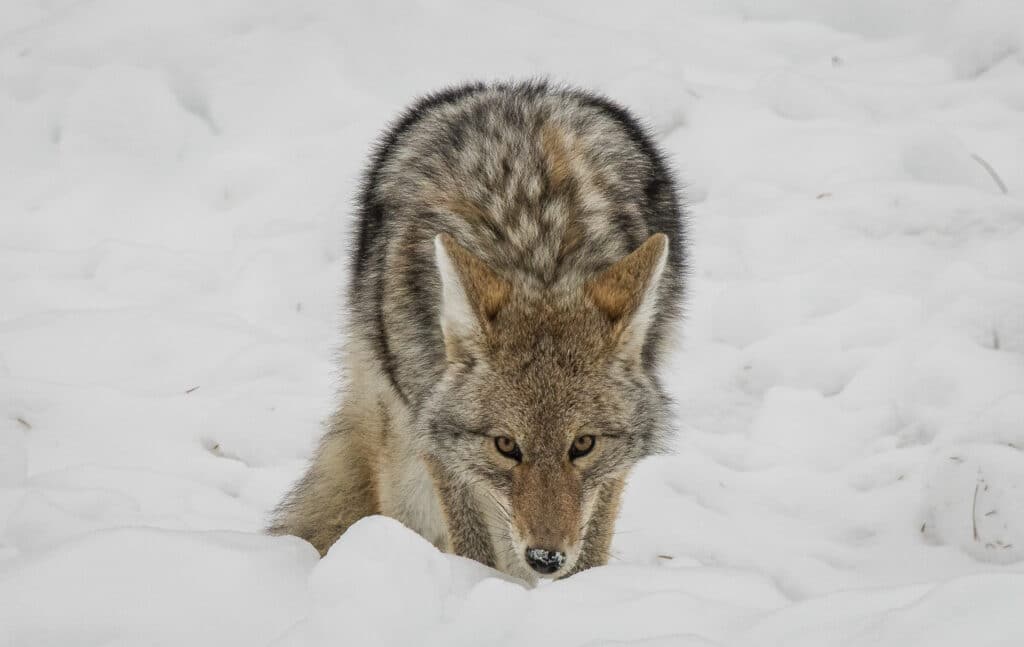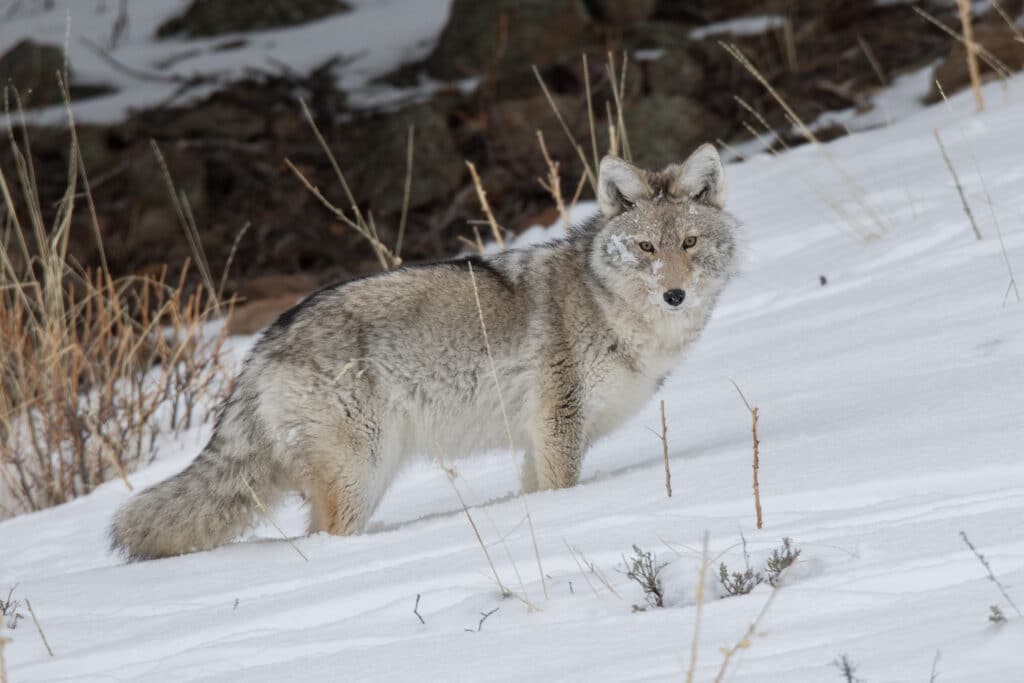Michigan Coyote Hunting Guide: Laws, tips, and where to hunt

I started hunting coyotes in Michigan when I was 12 years old. Technology has changed, but the heart of the hunt remains unchanged. Before you get started, you need to know the rules; what’s legal and what’s not.
In Michigan, coyotes are hunted both day and night with mostly small caliber rifles but sometimes shotguns too. They are called using distress calls. Often, a cottontail or jackrabbit in distress call. All types of calls, both man-powered and electronic, are legal. Any artificial decoy is legal, and you can hunt from an elevated platform like a raised blind or treestand, day or night.Decoys are sometimes used, and most shots are taken between 50 and 200 yards.
Here’s a cheat sheet published by folks at the Facebook group Michigan Coyote Hunting Outdoors, used with permission, for an additional hunting guide. It’s an image, so feel free to copy it to your phone or computer. Enlarge it for easier reading

Just a few more points. A non-resident needs both a Base License and a Fur Harvester License. Also, you do not need a license to take coyotes on private property for damage control. Here’s a quote directly from the MDNR 2021 Hunting Digest.
“Coyotes doing or about to do damage to private property on private land may be taken by the property owner or designee without a license year-round.”
2021 Michigan Huntin Digest
Firearm Regulations
Centerfire and rimfire guns are legal year-round, but nighttime hunting is limited to rifles and pistols with bullets under .269 caliber. So, basically a .260 or 6.5 Creedmoor is the upper limit of practical guns. For pistols that means something like a 5.7, an AR pistol in 223, or a 22 mag.
In-state parks or recreation areas, you can only use rimfire guns for nighttime hunting. For nighttime hunting, you also can’t use centerfire rifles or pistols on any public land in the limited firearm deer zone at night. If you’re hunting at night in the limited firearm zone, aka, shotgun zone, you may have to get creative.
Night vision and Thermal scopes are all legal. Suppressors are also legal. Another note about rifles; semi-auto rifles other than rimfire can have a magazine capable of holding no more than five rounds.
The most popular caliber is 223, but .224 Valkyrie and 22-250 are also commonplace. Custom-built AR 15’s are becoming the most popular rifle around, but bolt actions will always be a common choice. We have several articles on the ammo for coyote hunting. Here is a link to the Best Bullets for Coyote Hunting, and Here is a link to Best .223 Ammo for Coyote Hunting.
Michigan no longer has a bounty on coyotes. Michigan’s bounty on coyotes ended in 1975. From 1937 to 1975, Coyotes were considered invasive in the state, and eradication was attempted through a bounty system during that time.

Where to Hunt Coyotes in Michigan
Most of Michigan is equally good for coyote hunting. The lower peninsula has a stronger population due to easier winters, which means more successful hunting opportunities. The more rural land holds higher numbers of coyotes and is easier to hunt.
Generally speaking, rural southern Michigan counties have the highest population density of coyotes in the state. Every county in Michigan has a steadily increasing coyote population. That’s good for hunters.
The most popular area for coyote hunting is wide open farmland because you can see them coming from half a mile away, and there is an abundance of smaller animals. Suburban areas do hold coyotes, but not usually as many as farmland or Forrest land.
What makes a good coyote hunting area is a good food source. Their food source is primarily small mammals like mice, rabbits, and woodchucks, and also small birds. Where are these found the most?
Coyotes tend to congregate where there is an abundance of easy prey like grainfields, large patches of Autumn Olive when the berries are out, and meadows with lush green vegetation. Don’t forget a water source. All animals drink water.
Sure, we call in coyotes, but it can help to call them to an area they identify as a buffet. If you consider their hunting grounds while choosing a spot, you’re headed in the right direction. Just remember, you’re on their turf now. Tread lightly and keep your scent to yourself.
Coyotes are very scent-wary. Wash with non-scented soap and laundry detergent. Pro tip: a handful of salt with a tablespoon of borax and baking soda is a most excellent scent-killing laundry detergent. Relive yourself before the hunt, so you don’t end up marking your territory.
You must not stand out. Don’t wear camouflage that’s too dark. Dark camo sticks out more than light camo. Use natural concealments such as a tree stump or shrub.

Tips for Hunting Coyotes in Michigan
Coyotes travel along natural funnels and use available cover as they can. A coyote will often pop out from behind cover fairly close to you. Be vigilant and be still, they can show up at any time. Coyotes usually approach a hunter’s location from downwind. Setting up so you have an open view downwind will help you to see them early and get clean a shot off.
Using a bipod, tripod, or shooting stick will give you the accuracy of shooting prone, but you get your rifle above the grass and low growing brush for a clear shot.
Lightweight varmint bullets are most common in rifles, but fmj ammo like Hornady Frontier in 223 or 5.56 will still kill a coyote quite well. For shotshells, the most common shot size is #4 buckshot and 00 buckshot. Hornady makes the farthest-reaching buckshot for coyotes. They also have a coyote load of bb, which works alright.
Shotshells are realistically limited to about 50 yards, and rifles to around 200 yards, depending on the wind and your marksmanship skill. Use an electronic call, or get a mouth call and listen to skilled hunters using similar calls on YouTube. Try to mimic the natural distress sound of a coyote’s prey. Listen, learn, and practice.
